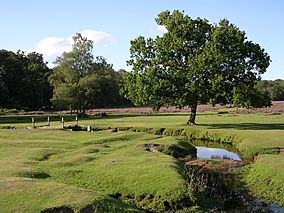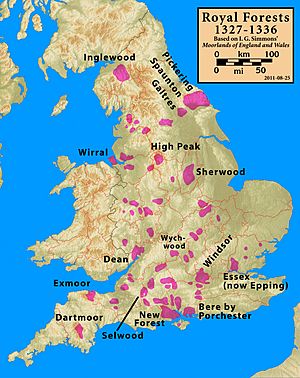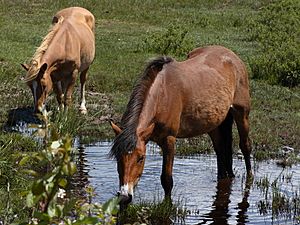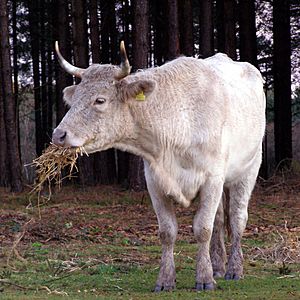New Forest facts for kids
Quick facts for kids New Forest National Park |
|
|---|---|
|
IUCN Category II (National Park)
|
|

The Beaulieu River cuts through Longwater Lawn, about 4 km (2 mi) from its source near Lyndhurst
|
|
| Location | Hampshire, England |
| Nearest city | Southampton |
| Area | New Forest National Park: 566 km2 (219 sq mi) New Forest: 380 km2 (150 sq mi) |
| Established | 1079 |
| Visitors | 14.75 million (est) (in 2009) |
| Governing body | New Forest National Park Authority |
| Designated: | 22 September 1993 |
The New Forest is a special area in southern England. It has large open spaces of heathland, forests, and grassy fields. This makes it one of the biggest natural areas left in the busy south east of England. It covers parts of Hampshire, Wiltshire, and Dorset.
The name "New Forest" also refers to the National Park that covers much of the same area. There are many small villages and towns both inside and around the edges of the Forest.
Contents
History of the New Forest
The New Forest was created by King William I around 1079. He made it a royal forest mainly for hunting deer. To do this, he cleared away more than 20 small villages and farms. This is why it was called "new" at the time, as it became one large hunting area.
The New Forest was first written about in the Domesday Book in 1086. This book described it in more detail than any other forest. People often talk about how famous William I was for creating the New Forest.
Two of William's sons died in the Forest. His son Prince Richard died in 1081, and King William II (also known as William Rufus) died in 1100. Old stories say this was a punishment for how William created the Forest. Some people believed it was wrong to destroy homes to make a hunting ground.
The special rights of local people, called common rights, were officially protected by law in 1698. The New Forest also became important for providing wood for the Royal Navy's ships. Many trees were planted in the 1700s for this reason. A huge storm in 1703 destroyed about 4,000 oak trees. Later, in 1877, a new law gave the Forest even more protection.
The New Forest in Modern Times
The New Forest Act of 1877 made sure that the historic rights of the Commoners were kept safe. It also stopped too much land from being fenced off. During the First World War, many broadleaf trees were cut down and replaced with conifer trees to provide wood for the war. More changes happened during the Second World War.
Today, some of these areas are being changed back to their original heathland or broadleaf woodland. However, a plant called Rhododendron is still a problem in some parts.
As of 2005, the Crown (the King or Queen) still owns about 90% of the New Forest. The Forestry Commission has managed these lands since 1923. Most of the Crown lands are now part of the new National Park.
More laws were passed in 1949, 1964, and 1970 to protect the Forest. In 1971, it became a SSSI, which means it's important for its wildlife. It was named the New Forest Heritage Area in 1985, with even more rules to protect it. In 1999, it was suggested as a UNESCO World Heritage Site. Finally, in 2005, the New Forest officially became a National Park.
Common Rights in the New Forest
Forest laws were made to keep the New Forest a good place for royal deer hunting. If anyone bothered the King's deer or their food, they would be punished. But the people living in the area, called commoners, had special rights that existed before these laws.
These rights allowed commoners to:
- Let their horses and cattle (but rarely sheep) graze freely in the Forest. This is called common pasture.
- Collect wood for fuel.
- Cut peat (a type of soil) for fuel.
- Dig for clay, known as marl.
- Let their pigs roam between September and November to eat fallen acorns and beechnuts. This is called pannage or mast.
Grazing and pannage are still very important for keeping the Forest healthy. Pigs can eat acorns without problems, but too many acorns can be poisonous to ponies and cattle. Pannage always lasts for 60 days. The exact start date changes each year, depending on when the acorns fall. The Verderers, who manage the Forest, decide when pannage will begin.
At other times, pigs must be kept on their owner's land. However, pregnant sows (female pigs) called privileged sows are always allowed out. They must not cause trouble and must return to their owner's home at night. Commoners must also have other land outside the Forest to keep their animals if needed.
The grazing of commoners' ponies and cattle is a key part of managing the Forest. It helps keep the heathland, bogs, grasslands, and woodlands in good condition for wildlife. In the past, these rights were linked to specific pieces of land. This made it hard for younger commoners to get homes with these rights.
Now, efforts are being made to help commoners continue their important work. This helps them earn a living and ensures they can keep helping to preserve the unique New Forest.
Images for kids
-
Alder trees by the Beaulieu river at Fawley Ford, north of Beaulieu
-
Lyndhurst, the "capital" of the New Forest, in 2020
See also
 In Spanish: New Forest para niños
In Spanish: New Forest para niños













